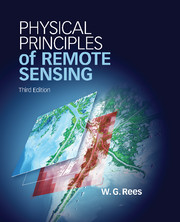Book contents
- Frontmatter
- Contents
- Preface
- Acknowledgements
- 1 Introduction
- 2 Electromagnetic waves in free space
- 3 Interaction of electromagnetic radiation with matter
- 4 Interaction of electromagnetic radiation with the Earth's atmosphere
- 5 Photographic systems
- 6 Electro-optical systems
- 7 Passive microwave systems
- 8 Ranging systems
- 9 Scattering systems
- 10 Platforms for remote sensing
- 11 Data processing
- Appendix Data tables
- References
- Index
- Plate Section
7 - Passive microwave systems
Published online by Cambridge University Press: 05 December 2012
- Frontmatter
- Contents
- Preface
- Acknowledgements
- 1 Introduction
- 2 Electromagnetic waves in free space
- 3 Interaction of electromagnetic radiation with matter
- 4 Interaction of electromagnetic radiation with the Earth's atmosphere
- 5 Photographic systems
- 6 Electro-optical systems
- 7 Passive microwave systems
- 8 Ranging systems
- 9 Scattering systems
- 10 Platforms for remote sensing
- 11 Data processing
- Appendix Data tables
- References
- Index
- Plate Section
Summary
In Chapters 5 and 6 we considered passive remote sensing systems in which the diffraction resolution limit λ/D, while important, was not usually a critical parameter of the operation. In this chapter we consider our last major class of passive remote sensing system, the passive microwave radiometer. This is a device that measures thermally generated radiation in the microwave (usually 5–100 GHz) region. (Frequencies much below 1 GHz are unsuitable because of the large signal contributed by the Galaxy, as well as the difficulty of achieving adequate spatial resolution.) As we discussed in Section 2.6, the long ‘tail’ to the Planck distribution at relatively low frequencies means that measurable amounts of radiation are emitted even in this range of frequencies.
Because microwave wavelengths are so much greater than those of visible or even of thermal infrared radiation, the resolution limit plays a much more important role, and we shall need to give more attention to the factors that determine it. More detailed technical treatments of antenna theory are given by Ulaby, Moore and Fung (1981) and by Sharkov (2003), amongst others. Much of the technology and nomenclature of passive microwave radiometry was originally developed in the field of radio astronomy, and further details can also be found in works on that subject.
- Type
- Chapter
- Information
- Physical Principles of Remote Sensing , pp. 223 - 249Publisher: Cambridge University PressPrint publication year: 2012



